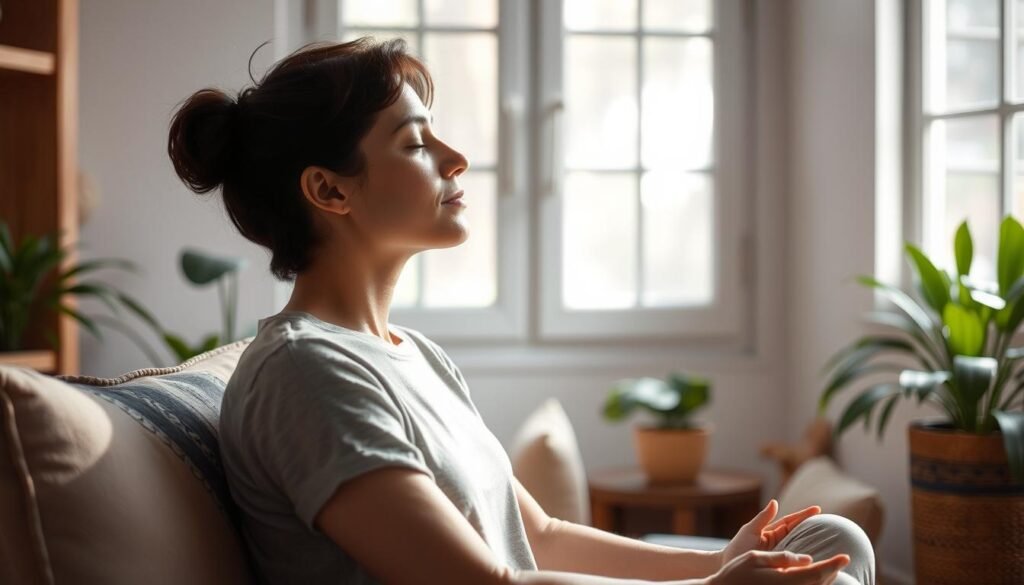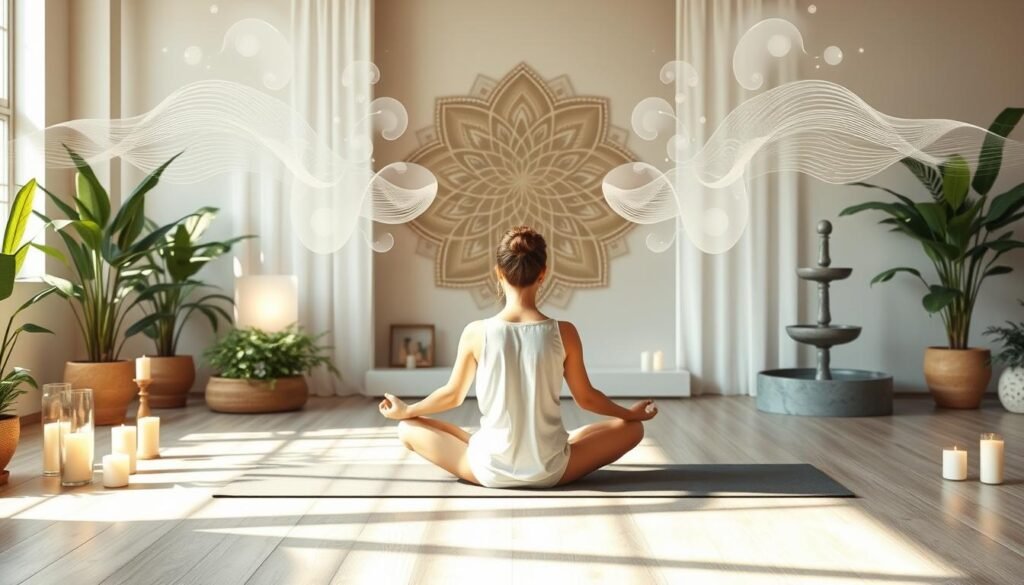Hyperventilating can actually cut down oxygen-rich blood to our brains. This can make anxiety feel even worse. It shows how closely linked our breathing and emotions are. In today’s fast-moving world, a lot of us feel anxious or short of breath. Most don’t know that easy breathing exercises can make a big difference. These methods are not just helpful, they can actually change how we feel. Doing relaxation exercises every day helps reduce stress. It also lets people manage their anxiety better.
This article will cover different ways to improve your breathing. It aims to help people deal with their anxiety better. You’ll learn about deep breathing and how to be more mindful. These techniques are simple to add to your daily life. They offer both hope and relief when you’re feeling worried.
Key Takeaways
- Hyperventilation negatively impacts oxygen flow to the brain, worsening anxiety.
- Practicing abdominal breathing for just 10 minutes a day can ease breathlessness.
- Deep, focused breathing can significantly lower anxiety levels.
- Equal breathing promotes balance, bringing a sense of fullness and calm to the lungs.
- Various breathing techniques, including pranayama and lion’s breath, can reduce stress and anxiety.
- Mindfulness and guided meditation can effectively interrupt stress patterns and promote relaxation.
Understanding Anxiety and Its Impact on Breathing
Anxiety can make you feel many things, including physical symptoms. It often causes shortness of breath that feels intense. Even when you can breathe normally, this feeling can be hard to handle.
When you’re anxious, your body reacts in ways that make you short of breath. Stress makes you breathe faster and tightens your chest and throat muscles. This changes how you breathe and makes your anxiety worse.
Sometimes, anxiety makes you suddenly feel like you can’t breathe deeply. Stressful events or thoughts can trigger this. Knowing about this symptom is the first step in getting better.
Many things might make you short of breath, like colds, asthma, or smoking. But it’s important to know when anxiety is the reason. When stress is the cause, this breathing trouble stays around longer, after other reasons are checked off. Realizing anxiety might be behind it helps you look for ways to feel better.
To deal with anxiety-related breathlessness, try deep breathing or mindfulness. Things like staying grounded, being active, or getting therapy can help too. For more on how anxiety affects breathing, check out this resource.
What Are Breathing Exercises?
Breathing exercises help us relax and reduce anxiety. They make us focus on our breath for mindfulness and emotional control. This leads to peace and better mental clarity.
These exercises are quick, perfect for those with little time. Doing them once or twice a day is good for routine. If you do them for 10 minutes or more, you’ll feel even calmer.
Adding muscle relaxation makes breathing exercises more powerful. It mixes breathing control with muscle tension and release. Using equal breaths in and out is key for balance.
Your place and clothes affect how well you can do these exercises. Using visualization and affirmations makes the practice fuller. It helps in managing stress better.
Breathing Exercises to Combat Shortness of Breath from Anxiety
Anxiety can make you feel like you can’t breathe well. This can make you feel even more stressed and upset. Learning special breathing exercises can help calm your anxiety and make breathing easier. Knowing how to breathe deeply gives you a strong way to lower your anxiety levels.
Importance of Deep Breathing Techniques
Deep breathing helps lessen anxiety symptoms. It promotes relaxation and helps get more oxygen into the body. People who breathe too fast can slow down by doing diaphragmatic breathing. This type of breathing calms you down. It lowers your heart rate and blood pressure. This makes you feel more relaxed and improves your overall well-being. You can practice deep breathing anywhere. This helps you handle anxiety in your daily life.
How Breathing Affects the Nervous System
Breathing well can change how your nervous system works. Studies show that certain breathing techniques can make you feel calmer. Experts say you should try to breathe slowly, about four to ten times a minute, to relax the best. Doing deep breathing exercises often makes relaxation come more naturally. It helps stop the “fight-or-flight” feeling that anxiety causes.
| Breathing Technique | Benefits | Recommended Practice |
|---|---|---|
| Diaphragmatic Breathing | Reduces anxiety, increases oxygen levels | Practice for 3-5 minutes, anytime |
| Pursed-Lip Breathing | Slows breathing, beneficial for lung conditions | Inhale through the nose, exhale slowly through pursed lips |
| Resonance Breathing | Induces calmness and relaxation | Breathe in for 6 seconds, out for 6 seconds |
| Yogic Breathing | Balances body and mind | Focus on expanding the belly with each inhale |
| Mindful Breathing | Improves focus, reduces stress | Incorporate into daily routine for best results |
By using these breathing methods, people can better manage their anxiety. This leads to less panic and a healthier way of dealing with stress.
Benefits of Using Breathing Exercises for Anxiety Management
Practicing breathing exercises daily brings major benefits for those suffering from anxiety. These methods are great for calming the mind and improving emotional health. Here are some key advantages of regular breathing exercise practice.
Reducing Symptoms of Anxiety
Breathing exercises significantly lower anxiety symptoms. One effective technique is the 4-7-8 method. It triggers the body’s calm response. You inhale for four seconds, hold your breath for seven, and exhale for eight.
This helps slow down your heart rate and reduce blood pressure. That way, it controls anxiety well. Many find these exercises helpful for quieting busy thoughts and bringing peace.
Improving Overall Well-being
Practicing breathing techniques regularly betters your overall emotional health. Those who do deep breathing often feel more content and less stressed. Doing these exercises often can make your immune system stronger by getting stress hormones under control and enhancing blood circulation.
This approach not only helps manage anxiety. It also strengthens your mental health, making you more resilient to daily stressors.

Diaphragmatic Breathing: The Foundation of Relaxation
Diaphragmatic breathing is also known as belly breathing. It’s a core method for increasing relaxation. This technique involves deep breathing with the diaphragm. This leads to a fuller, more effective breath than the shallow breathing many of us do.
Diaphragmatic breathing helps in managing stress and anxiety. It gives people a way to handle their emotions better. By doing so, it activates a calm response in the body. This helps ease problems like irritable bowel syndrome and chronic pancreatitis. It also lowers blood pressure and improves lung function.
Here’s how to start this relaxation method:
- Place one hand on your chest and the other on your belly.
- Inhale deeply through your nose, making your belly rise. Keep your chest still.
- Exhale slowly through your mouth, letting your belly lower.
- Do this for 5 to 10 minutes, about three to four times a day at first.
Over time, you can do diaphragmatic breathing more often and for longer. This not only helps with anxiety. It also provides a method for long-term stress management.
| Benefits of Diaphragmatic Breathing | Details |
|---|---|
| Reduces Anxiety | Activates the relaxation response, helping to alleviate feelings of stress. |
| Enhances Digestion | Calms spasms and cramps associated with digestive issues. |
| Improves Lung Capacity | Utilizes lung capacity more effectively by engaging the diaphragm fully. |
| Lowers Blood Pressure | Can contribute to reducing overall blood pressure levels. |
| Long-term Strategy | A simple technique that can be mastered for ongoing relaxation benefits. |
Making diaphragmatic breathing part of your daily life can boost your well-being greatly. It becomes a key practice for those wanting better relaxation methods.
Pursed-Lip Breathing: A Simple Technique for Control
Pursed-lip breathing is a key method for gaining control over breath when feeling anxious or short of breath. It helps lung function and boosts oxygen levels. The process is simple: breathe in through the nose and breathe out slowly through pursed lips. This method allows for better control of airflow. By doing this, people can reduce their breathlessness in daily life.
Practicing pursed-lip breathing ten times an hour is advised for the best outcomes. Using this technique, especially after being active, can help increase stamina and function. Doing it regularly helps those with breathing issues feel less anxious and do tasks more easily.

Diaphragmatic breathing is another technique that should be practiced with pursed-lips. This method involves using the diaphragm more during breathing, which is good for people with COPD. Try doing it for five to ten minutes, two to three times daily. Getting advice from a health professional can also be very helpful.
Using these effective breathing methods isn’t just for physical activity. Adding pursed-lip breathing to daily routines helps create calmness and reduce stress. People who master these techniques often feel emotionally stronger, which helps mental and physical health.
Learning more about controlling breath can truly change a person’s life. Exploring different breathing techniques can expand the benefits, leading to better anxiety management and more relaxation.
Exploring Other Effective Breathing Techniques
Adding different breathing techniques to your routine helps manage anxiety better. Two methods stand out: equal breathing and resonant breathing. Both focus on breath rhythm to bring calmness and relaxation.
Equal Breathing Method
The equal breathing method makes you inhale and exhale for the same time. Counting to four or six seconds for each breath is common. It slows down your heart rate and calms you. Doing this for 10 to 20 minutes daily can boost relaxation. It’s an effective breathing technique for anxiety reduction.
Adding it into a daily anti-anxiety plan can greatly lessen symptoms.
Resonant Breathing Techniques
Resonant breathing, or coherent breathing, is about maintaining a steady breathing rate of about 5 breaths per minute. It encourages taking deeper breaths. This enhances the balance between body’s stress and rest systems. This not only relaxes you but also improves brain function and emotional health.
Regularly practicing these anti-anxiety tips can significantly lower anxiety. For more information, check out various breathing exercises for anxiety relief.
Integrating Mindfulness Practices with Breathing Exercises
Mixing mindfulness with breathing exercises makes a strong combo. It boosts how well we can control our feelings and stay in the now. Focusing on breathing helps us connect more with ourselves.
Doing mindfulness regularly makes breathing exercises work better. Activities like guided meditation make us feel more relaxed and clear. Studies show meditation helps with sleep, focus, and even asthma and fibromyalgia.
Practicing mindfulness outside makes it even better. Using our senses during the practice makes it richer. It helps us stay in the moment and calms our mind and body.
Exercises like body scan or sitting meditation are great for deep breathing. They need a quiet place with no distractions. Doing this every day for six months can turn mindfulness into a habit.

Adding different breathing techniques, like the 4-7-8 method, reduces anxiety and stress. These techniques lower stress if practiced regularly. Sticking with it can lead to big improvements in how we feel overall.
Tips for Establishing a Daily Breathing Routine
A daily breathing routine helps you manage stress and cope with anxiety better. Starting with easy steps lets you fit breathing exercises into your day. Setting aside specific times for this is key. You could choose either morning or evening, making it a regular part of your schedule.
If it’s hard to remember your practice times, use phone reminders or notes in visible places. It’s important to have a comfy spot for relaxation. Create a space where you’re away from distractions. This lets you focus on your breathing. Adding soft lights and gentle music can also make the area more relaxing.
To keep your routine interesting, try different breathing methods. Starting with five deep breaths is good for beginners. If that’s hard, try inhaling for 3 counts and exhaling for 6 to calm down faster. Or, adjust the counts to what feels right for you, like 2 and 4 or 4 and 8 for longer breaths.
Box breathing is also a great choice. It involves breathing in, holding your breath for 4 counts, breathing out, and holding again. It helps you focus and feel in control. Alternate nostril breathing balances your brain for peace of mind.
Practicing these techniques regularly makes you stronger. Mindfulness connects you to the present, using your senses. Adding progressive muscle relaxation (PMR) helps too. It teaches you to notice tension and relaxation in your body.
These methods give you a plan for handling stress, leading to better emotional health. Taking it step by step lets anyone create a breathing routine. This can lessen anxiety and boost mental well-being.
Conclusion
Breathing exercises offer a simple way to fight off anxiety and breathlessness. By taking control of their breathing, people can feel calmer. This improves their health a lot. Research, including studies on COVID-19 patients, shows that guided breathing reduces anxiety.
There’s still a lot to learn about how these exercises help. But what we know is promising, especially for those looking to ease anxiety. Adding simple breathing exercises to daily life can make a big difference in mental and physical health.
Everyone should try out different breathing methods to see what’s best for them. Starting small can lead to better wellness. Using these techniques reduces anxiety and leads to a happier, more balanced life.